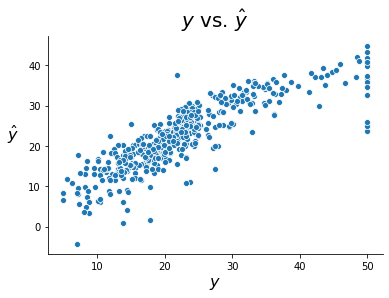Construction¶
This section demonstrates how to construct a linear regression model using only numpy. To do this, we generate a class named LinearRegression. We use this class to train the model and make future predictions.
The first method in the LinearRegression class is fit(), which takes care of estimating the \(\bbeta\) parameters. This simply consists of calculating
The fit method also makes in-sample predictions with \(\hat{\by} = \bX \bbetahat\) and calculates the training loss with
The second method is predict(), which forms out-of-sample predictions. Given a test set of predictors \(\bX'\), we can form fitted values with \(\hat{\by}' = \bX' \bbetahat\).
import numpy as np
import matplotlib.pyplot as plt
import seaborn as sns
class LinearRegression:
def fit(self, X, y, intercept = False):
# record data and dimensions
if intercept == False: # add intercept (if not already included)
ones = np.ones(len(X)).reshape(len(X), 1) # column of ones
X = np.concatenate((ones, X), axis = 1)
self.X = np.array(X)
self.y = np.array(y)
self.N, self.D = self.X.shape
# estimate parameters
XtX = np.dot(self.X.T, self.X)
XtX_inverse = np.linalg.inv(XtX)
Xty = np.dot(self.X.T, self.y)
self.beta_hats = np.dot(XtX_inverse, Xty)
# make in-sample predictions
self.y_hat = np.dot(self.X, self.beta_hats)
# calculate loss
self.L = .5*np.sum((self.y - self.y_hat)**2)
def predict(self, X_test, intercept = True):
# form predictions
self.y_test_hat = np.dot(X_test, self.beta_hats)
Let’s try out our LinearRegression class with some data. Here we use the Boston housing dataset from sklearn.datasets. The target variable in this dataset is median neighborhood home value. The predictors are all continuous and represent factors possibly related to the median home value, such as average rooms per house. Hit “Click to show” to see the code that loads this data.
from sklearn import datasets
boston = datasets.load_boston()
X = boston['data']
y = boston['target']
With the class built and the data loaded, we are ready to run our regression model. This is as simple as instantiating the model and applying fit(), as shown below.
model = LinearRegression() # instantiate model
model.fit(X, y, intercept = False) # fit model
Let’s then see how well our fitted values model the true target values. The closer the points lie to the 45-degree line, the more accurate the fit. The model seems to do reasonably well; our predictions definitely follow the true values quite well, although we would like the fit to be a bit tighter.
Note
Note the handful of observations with \(y = 50\) exactly. This is due to censorship in the data collection process. It appears neighborhoods with average home values above $50,000 were assigned a value of 50 even.
fig, ax = plt.subplots()
sns.scatterplot(model.y, model.y_hat)
ax.set_xlabel(r'$y$', size = 16)
ax.set_ylabel(r'$\hat{y}$', rotation = 0, size = 16, labelpad = 15)
ax.set_title(r'$y$ vs. $\hat{y}$', size = 20, pad = 10)
sns.despine()

